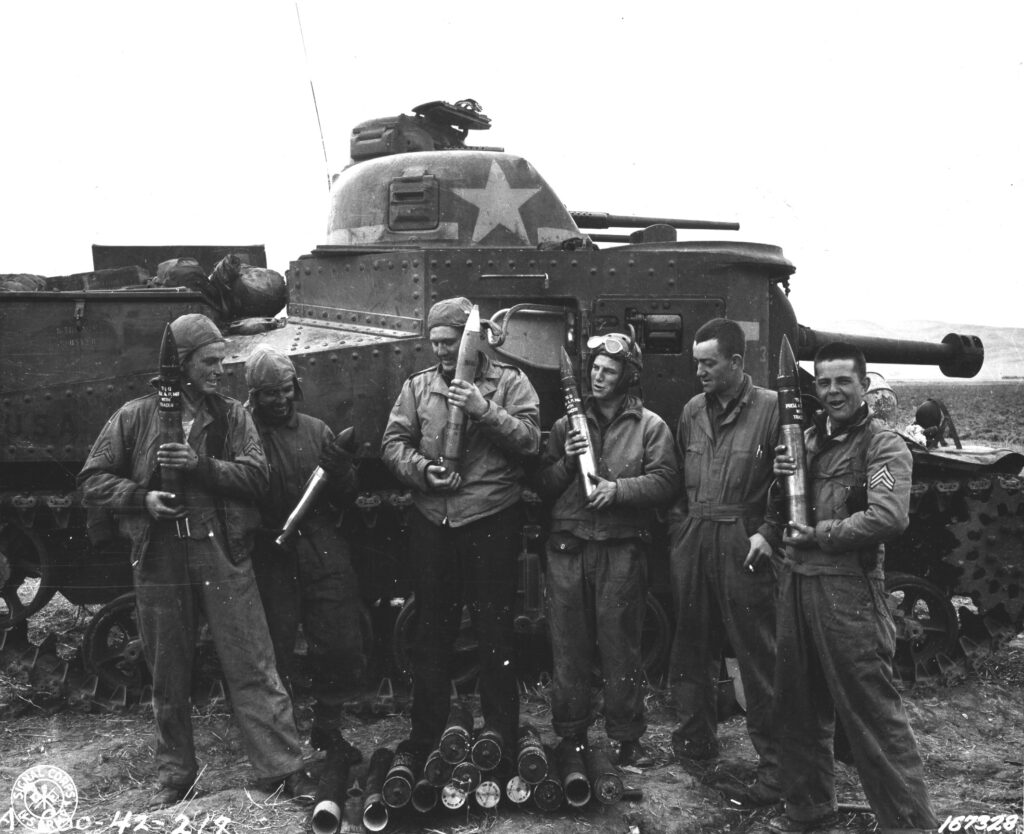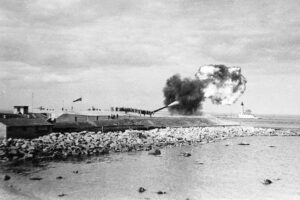By Matthew Seelinger
The origins of the 13th Armor date back to 2 February 1901, when the regiment was constituted in the Regular Army as the 13th Cavalry. The 13th was later activated on 1 May 1901 at Fort Meade, South Dakota. After briefly serving in the western United States, the 13th conducted two tours in the Philippines, first from 1903 to 1905, then from 1909 to the end of 1910. After returning to the United States from the Philippines, the 13th served along the U.S.-Mexico border from 1911 until 1921. During the early years of the 13th cavalry’s history, the regiment also gained the designation 13th Horse.
Four troops of the regiment and the machine gun platoon were posted at Camp Furlongnear Columbus, New Mexico, when Mexican bandit Pancho Villa and his men raided the town in the early hours of 9 March 1916. While taken by surprise, the 13th Cavalry troopers, under the command of COL Herbert J. Slocum, quickly rallied and drove the attackers back across the border, killing over 100 raiders in the process. Eight soldiers were killed in the attack, along with nine civilians. MAJ Frank Tompkins organized a pursuit force with men from two troops and chased the raiders fifteen miles into Mexican territory until a shortage of ammunition and water forced them to turn back.
President Woodrow Wilson ordered immediate retaliation for Villa’s raid and directed BG John J. “Black Jack” Pershing to lead what became known as the Punitive Expedition. On 16 March, American units, including four cavalry regiments, two infantry regiments, and two batteries of field artillery, crossed into Mexico in an effort to capture Pancho Villa. Leading the expedition across the border was the 13th Cavalry, with MAJ Tompkins on point. During the expedition, troopers from the 13th conducted patrols as far south as San Antonio, Mexico, the southernmost advance by American soldiers during operations south of the border. During the withdrawal from Mexico on 5 February 1917, the 13th Cavalry served as the rear guard of the expeditionary force, making it the first and last American unit in Mexico.

Following the American declaration of war against Germany in April 1917, the 13th Cavalry remained in the United States, serving briefly in Kansas and at a number of posts along the Texas-Mexico border. From 1920 to 1935, the regiment served primarily in Kansas, with its headquarters at Fort Riley. On 1 March 1933, the regiment was assigned to the 2d Cavalry Division; it was relieved from the 2d on 18 August 1936. In 1936, the 13th, now under the command of COL Charles I. Scott, became part of the 7th Cavalry Brigade (Mechanized), which served as a pioneer for the Army’s future armored force.
On 15 July 1940, the 13th Cavalry was redesignated the 13th Armored Regiment (Light) and assigned to the newly formed 1st Armored Division at Fort Knox, Kentucky. After taking part in the Arkansas, Louisiana, and Carolina Maneuvers in the summer and fall of 1941, the 13th returned to Fort Knox with the rest of the 1st Armored Division in December 1941. On 7 December, the regiment was redesignated the 13th Armored Regiment.
After additional training at Fort Knox, the 13th Armored, under the command of COL Paul Robinett, moved with the rest of the 1st Armored Division for Fort Dix, New Jersey, arriving on 10 April 1942. The 13th staged at Fort Dix until it left for Europe from the Portof New York on 13 May 1942. The regiment arrived in Northern Ireland on 11 June 1942 and underwent additional training in its M3 Stuart light and M3 Grant medium tanks.
On 8 November 1942, the 1st Battalion and 2d Battalions, 13th Armored, serving with the 1st Armored Division’s Combat Command B (CCB), took part in Operation Torch, the Allied landings in North Africa. CCB, part of Center Task Force’s Task Force Green, came ashore west of Oran, Algeria, against light resistance from Vichy French forces and entered the city two days later. The remainder of the 13th did not arrive in North Africa until 21 December.
Following the Algeria-French Morocco campaign, the 13th Armored, now under the command of COL Clarence C. Benson, advanced east into Tunisia, where it met German forces for the first time. While the Allies ultimately defeated the Axis forces, who surrendered in Tunisia on 13 May 1943, the 13th Armored suffered heavy losses during engagements at Sbeitla, Kasserine Pass, and other locations as the regiment’s light and medium tanks (including improved M5 Stuart light tanks newly arrived M4 Sherman mediums) were inferior to the more heavily armed and armored German Mk IV and Mk VI tanks.
After a period of rest, refitting, and training in North Africa, elements of the 13th Armored landed at Salerno, Italy, on 9 September 1943, with the rest of the regiment arriving in late October. When the Fifth Army’s drive north to Rome stalled in the late autumn and winter of 1943, LTG Mark Clark ordered VI Corps to conduct amphibious landings at Anzio in January 1944 in order to bypass the German Gustav Line. CCA of the 1st Armored Division took part in the initial landings; CCB, which included the 13th Armored, remained with II Corps and the fighting around Cassino.
The 13th Armored was later sent to Anzio in May 1944 to take part in the Allied breakout of the beachhead beginning on 23 May. During heavy fighting, the regiment suffered significant losses in tanks from to both enemy mines and guns. Soon after the breakout, however, Allied forces quickly advanced on Rome. Companies A and H of the 13th Armored were among the first Allied units to enter Rome when it fell on 4 June. After the fall of Rome, the 13th Armored continued to attack north with the 1st Armored Division until reaching Lake Bracciano.
In July 1944, the 1st Armored Division went into Fifth Army Reserve and underwent an extensive reorganization. As a result, the 13th Armored Regiment was broken up on 20 July, with the regiment’s Headquarters Company, Service Company, and Companies D, E, F redesignated as the 13th Tank Battalion; 3d Battalion and Maintenance Company as the 4th Tank Battalion; and the 13th’s Reconnaissance Company as Troop D, 81st Cavalry Reconnaissance Squadron, Mechanized. The remaining units of the regiment’s units were disbanded.
While the Allies’ attention shifted to Western Europe with the invasion of Normandy on 6 June 1944, the war continued on in Italy, as Allied forces advanced north against strong German resistance. The German defenders skillfully used the rugged Italian mountains to their advantage. Furthermore, the Italian topography, combined with the poor road network, hampered the effective use of armor and never allowed the Allies to fully exploit their advantage in mobility. Nevertheless, the units of the former 13th Armored Regiment slowly pushed their way north, seizing one enemy held position after another. By the time German forces surrendered in Italy on 2 May 1945, the 13th Tank Battalion had nearly reached the Swiss border. During World War II, the 4th and 13th Tank Battalions and Troop D, 81st Reconnaissance Squadron, participated in seven campaigns: Algeria-French Morocco (with arrowhead), Tunisia, Naples-Foggia, Anzio, Rome-Arno, North Apennines, and Po Valley.
After World War II, the 4th and 13th Tank Battalions were converted to the 72d and 13th Constabulary Squadrons, respectively, on 1 May 1946, while Troop D, 81st Reconnaissance Squadron, became the 81st Constabulary Squadron on the same date. After serving as occupation forces in Germany, all three units were inactivated on 20 September 1947.
After several periods of activation, reorganization, and inactivation in the 1950s, the units of the former 13th Armored were consolidated, reorganized, and redesignated as the 13th Cavalry, a parent regiment under Combat Arms Regimental System. On 3 February 1962, the 13th Cavalry was redesignated the 13th Armor, with the 1st and 2d Battalions, 13th Armor, assigned to the 1st Armored Division at Fort Hood, Texas.
In 1971, the 1st and 2d Battalions, 13th Armor, were relieved from the 1st Armored Division and assigned to the 1st Cavalry Division, which had recently returned from Vietnam to Fort Hood and had been reorganized from air assault to heavy armor. On 24 April 1973, the 2d Battalion, 13th Armor, was inactivated. In June 1974, the 1st Battalion was relieved from the 1st Cavalry Division and returned to the 1st Armored Division. The 1st Battalion, 13th Armor, served with the 1st Armored Division until 16 April 1988, when it was inactivated and relieved from the 1st Armored. In March 1987, the 2d and 4th Battalions, 13th Armor, were activated and assigned to U.S. Army Training and Doctrine Command, where they served as training units at the U.S. Army Armor School and Center at Fort Knox, Kentucky.
Following the inactivation of the 2d and 4th Battalions in early 1996, the 1st Battalion, 13th Armor (1-13 Armor), was activated on 16 February 1996 at Fort Riley, Kansas, and assigned once again to the 1st Armored Division, this time to the division’s 3d Brigade. From January through December 1997, 1-13 Armor served as part of Operation Joint Endeavor in Bosnia. During its time as peacekeepers in the Balkans, Company A, 1-13 Armor, earned an Army Superior Unit Award. The battalion later took part in operations along the Iraq-Kuwait border (Operation Desert Spring) from May to November 2002.

On 23 February 2003, 1-13 Armor received deployment orders to the CENTCOM area of responsibility in support of what would become Operation Iraqi Freedom. 1-13 Armor entered Iraq on 29 April 2003. The battalion was attached to the 3d Infantry Division and assumed control of Kadimiyah area of northwest Baghdad. 1-13 Armor conducted stability and security operations until it was redeployed back to Fort Riley on 2 April 2004.
Currently, 1-13 Armor is scheduled to participate in a transition team function as part of the Army’s transformation to a modular force. Plans call for the 13th Armor to convert back to 13th Cavalry, with two squadrons (1st and 2d) slated to serve as reconnaissance squadrons in the 1st Armored Division.



